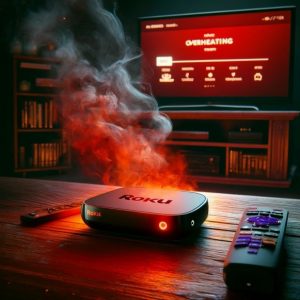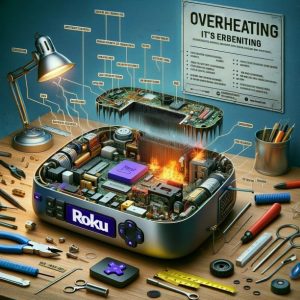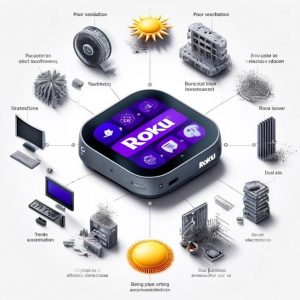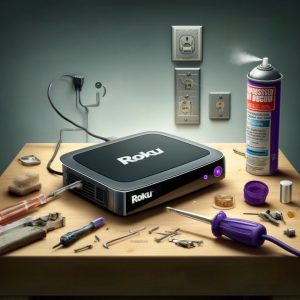Roku Device Overheating
Roku streaming devices have revolutionized the way we access entertainment, offering a user-friendly platform that aggregates numerous streaming services into one convenient interface. However, like all electronic devices, they are not without their issues. One common problem that users often encounter is Roku overheating. This issue can manifest as a Roku overheating message popping up on your screen, or you might notice that your device is overheating just by touching it.
The phrase Roku is overheating is becoming increasingly common in forums and support discussions, indicating that this is not an isolated issue. Roku device overheatingcomplaints can range from minor inconveniences to significant disruptions that affect device functionality and longevity. The message Roku your device is overheating serves as a direct warning from the system, urging users to take immediate action to prevent damage.
Addressing Roku device overheating is crucial not only for the immediate preservation of the device but also for its long-term performance and durability. Ignoring these warnings can lead to permanent damage, impacting the device’s functionality and potentially leading to a shorter lifespan. Therefore, understanding the underlying causes and learning how to effectively manage and mitigate Roku overheating is necessary for maintaining optimal performance and ensuring that you can enjoy your Roku device for many years to come.
Understanding Roku Overheating
Overheating in electronic devices occurs when components reach temperatures higher than those safe for optimal function. For devices like Roku, overheating can reduce performance, lifespan, and reliability. When a Roku starts to overheat, it can trigger an automatic shutdown to protect internal components, which is indicative of a Roku overheating scenario.
Signs of Roku Device Overheating
The signs of Roku overheating are fairly detectable. Physically, you might feel excessive heat emanating from the device or receive a Roku overheating message on your screen. This is a clear indicator that your device is overheating and steps need to be taken to cool it down. In terms of performance, an overheating Roku may experience freezing, unexpected restarting, or complete shutdowns. These issues are not only frustrating but can also interrupt your viewing experience, indicating that Roku is overheating.
Why Overheating Occurs
The causes of overheating in Roku devices can be categorized into internal and external factors:
-
Internal Factors:
Hardware limitations are a common internal factor. Some Roku models may have components that generate more heat than the device’s cooling mechanisms can handle, especially during intense processing tasks like streaming 4K content. Firmware issues can also contribute to device overheating Roku, where bugs or inefficient processing tasks lead to excessive heat generation.
-
External Factors:
The environment in which your Roku device operates plays a significant role in its temperature regulation. High ambient temperatures, such as those in tightly enclosed spaces or areas with inadequate airflow, can exacerbate Roku overheating problems. Improper ventilation around the Roku device, such as stacking it with other electronics or confining it in a closed cabinet, can prevent heat from dissipating effectively, leading to the dreaded your Roku device is overheating message.
Understanding these factors is essential in diagnosing and resolving overheating issues with your Roku. By recognizing the signs and identifying the causes, you can take proactive measures to prevent form overheating and ensure your Roku operates within safe temperature ranges.
Common Causes of Roku Overheating
Understanding the causes of Roku overheating is key to maintaining your device’s health and ensuring a seamless streaming experience. This section explores into the various factors that can lead to overheating and provides practical tips to mitigate these issues.
-
Placement and Ventilation:
One of the most straightforward yet overlooked causes of Roku overheating involves how and where the device is placed. Proper device placement is critical, as poor ventilation can trap heat and cause the device temperature to rise rapidly. To prevent Roku device overheating or issues with other models like the Roku Express, Roku Streaming Stick, and Roku Ultra, ensure there is adequate space around the device for air to circulate freely. Avoid placing your Roku in enclosed spaces, near other heat-generating devices, or in direct sunlight.

- Use a stand or mount to elevate your Roku above hard surfaces.
- Ensure at least 2 inches of space between your Roku and other objects.
- Avoid placing your Roku inside tightly closed cabinets without ventilation.
-
Intensive Usage Patterns:
Roku overheating can also result from intensive usage patterns, such as streaming high-resolution content for prolonged periods. Devices like Roku TV and Roku Ultra, which support high-definition streaming, may become especially hot during extended use. To manage heat:
- Take breaks between long streaming sessions to allow your Roku to cool down.
- Consider lowering the streaming resolution during marathon sessions to reduce the processing load on your Roku.
-
Environmental Factors:
The environment in which you place your Roku can significantly affect its operating temperature. External elements such as high ambient temperatures or placing your Roku in confined spaces without adequate airflow can lead to Roku overheating. During hot weather, it may be beneficial to:
- Enhance room ventilation using fans or air conditioning.
- Keep your Roku away from windows or other sources of direct sunlight.
-
Accessory Use:
Finally, the use of certain accessories can contribute to Roku overheating. While accessories are often necessary for enhancing functionality, they can sometimes block ventilation ports or generate additional heat that can affect your Roku. When using accessories like HDMI extenders or additional audio equipment, ensure they do not obstruct air flow around your Roku device.
By addressing these common causes, you can significantly reduce the risk of Roku Overheating and ensure your device performs optimally, free from the risks associated with excessive temperature increases.
How to Fix Roku Overheating
When you encounter Roku overheating, it’s crucial to act swiftly to prevent damage to your device and ensure ongoing functionality. This section provides a structured approach to cooling down your Roku and implementing long-term solutions to avoid future overheating issues.
Immediate Steps to Cool Down Your Roku
If your Roku displays a overheating message or you notice that your device is overheating, there are several immediate actions you can take:
-
Turning Off the Device:
Power down your Roku to stop all operations and give it a chance to cool. This step is vital in preventing internal damage caused by excessive heat.
-
Removing It from Confined Spaces:
If your Roku is in a confined space, move it to an open area with better air circulation. This will help dissipate the heat more efficiently and reduce the temperature of the device.
Long-Term Solutions
To prevent future Roku overheating, consider the following strategies for placement and accessory use:
-
Recommendations for Roku Placement:
Ensure that your Roku is placed in a location with good airflow. Avoid stacking it with other electronics that could contribute to heat buildup. Consider using a wall mount or a ventilated stand to keep it away from other heat sources and ensure air can circulate around the device freely.
-
Suggested Accessories to Reduce Heat:
Use heat sinks or additional cooling fans designed for electronics. These can help in managing the temperature of your Roku, especially models prone to overheating like the Roku Ultra and Roku Streaming Stick.
-
Firmware Updates:
Frequently check for firmware updates for Roku. Updates often include fixes that improve device efficiency and cooling management, reducing the likelihood of Roku overheating.
-
Factory Reset:
If overheating persists, consider performing a factory reset. This can resolve issues caused by corrupted data or misconfigurations that may be causing your device to work harder than necessary, leading to Roku stick overheating or similar issues in other models.
Implementing these solutions can significantly mitigate the risk of Roku overheating. By taking immediate action to cool down your device and applying long-term preventative measures, you can enjoy uninterrupted streaming and extend the lifespan of your Roku.
Preventing Future Roku Overheating
To ensure that Roku overheating does not become a recurrent problem, maintaining your device properly and considering strategic upgrades are crucial. This section explores maintenance practices, potential upgrades, and tools to help you manage device temperature effectively.
Maintenance Tips
Regular maintenance is key to preventing Roku overheating. Here are some essential tips:
-
Regular Cleaning and Dusting:
Keep your Roku device dust-free, which can accumulate and block air vents. Dust buildup can insulate heat, preventing it from escaping and thereby increasing the internal temperature of the device.
-
Checking for Obstructions in Ventilation Areas:
Periodically inspect the area around your Roku to ensure there are no obstructions blocking the airflow. Make sure the ventilation openings on your Roku are not covered or close to surfaces that could restrict air circulation.
-
Considering an Upgrade to Newer Models with Better Heat Management:
Newer Roku models, like the Roku Ultra and Roku Streaming Stick, often incorporate better heat management technologies and improved hardware efficiency. Upgrading to a newer model can help mitigate Roku device overheating issues.
-
Evaluating Alternative Streaming Options with Better Heat Dispersion:
Consider other streaming devices that are known for better heat dispersion if your current Roku model continues to have overheating issues despite following maintenance tips.
By adhering to these maintenance tips, considering upgrades, and using monitoring tools, you can effectively prevent Roku overheating and ensure that your Roku operates within safe temperature limits, thereby extending its lifespan and enhancing its performance.
FAQs
Q1. Why is my Roku remote not working when I get a Roku Overheating message?
- A: If you see a Roku overheating message, the high temperature may affect the performance of your Roku device, including the remote. Reduce the heat by turning off the device and improving ventilation to restore remote functionality.
Q2. Can Roku device overheating affect the response time of my Roku Remote?
- A: Yes, Roku device overheating can lead to slower response times or unresponsiveness from your Roku remote. Cooling down your Roku can help restore normal operation.
Q3. What should I do if my Roku Stick Overheating is causing my remote to malfunction?
- A: If Roku stick overheating is suspected, ensure the device is not in a confined space, increase airflow around the device, and check if the remote functions properly once the device cools down.
Q4. How can Roku TV Overheating impact my remote’s connectivity?
- A: Roku TV overheating can disrupt the infrared signal or wireless connection between the TV and the remote. Maintaining a cooler environment for your Roku TV can prevent these issues.
Q5. Will my Roku Remote Stop Working if there is a Roku TV overheating message displayed?
- A: A Roku TV overheating message indicates excessive temperature, which might temporarily interfere with remote operations. Address the overheating issue promptly to regain full remote functionality.
Q6. What are the signs that my Roku is overheating, affecting the remote control?
- A: Signs that Roku is overheating include system instability, unexpected shutdowns, and remote connectivity issues. Cooling down your Roku should help resolve remote control problems.
Q7. Is there a Roku Stick Overheating fix that can also solve remote connectivity problems?
- A: A fix for Roku stick overheating involves improving air circulation and possibly attaching a heat sink. This can also improve the remote’s connectivity by stabilizing the device’s operation.
Q8. Can the overheating of Roku affect how my remote works with Roku Express?
- A: Yes, Roku Express overheating can cause the device to malfunction, potentially affecting how the remote interacts with the Roku Express. Ensure good ventilation to mitigate this issue.
Q9. What steps can I take if my Roku Ultra Overheating is causing remote control issues?
- A: To address Roku Ultra overheating that affects the remote, ensure the device is not placed on heat-sensitive surfaces, use a cooling stand, and keep the firmware updated for optimal performance.
Q10. How do I troubleshoot my Roku Remote if my Roku Device Is Overheating?
- A: If my Roku device is overheating, first cool down your Roku by turning it off and improving the surrounding airflow. Once the temperature is normalized, restart the device and check if the remote is functioning correctly.
Conclusion
Throughout this guide, we have addressed the critical issue of Roku overheating, highlighting the importance of managing device temperature to safeguard your streaming experience and prolong the lifespan of your Roku. As we’ve seen, Roku overheating can manifest in various forms—from a Roku overheating message to more subtle signs like performance degradation. This issue is not only common in older models like Roku Express and Roku Stick, but it can also affect newer devices such as Roku Streaming Stick and Roku Ultra.
We’ve explored multiple strategies to mitigate and prevent Roku overheating, from ensuring proper placement and ventilation to undertaking regular maintenance such as cleaning and checking for obstructions. Additionally, we’ve discussed the benefits of upgrading to models with better heat management and using third-party monitoring tools to keep an eye on device temperature.
By following the comprehensive advice provided in this guide, you can enhance your device’s performance and avoid the pitfalls of Roku device overheating. Implementing these tactics will not only increase your current viewing experience but also extend the operational life of your Roku, making it a reliable entertainment partner for years to come.
We encourage all Roku users to remain vigilant about their device’s operating conditions and to revisit this guide periodically for tips on maintaining optimal performance. Remember, taking proactive steps to manage your Roku overheating issues can make a significant difference in your device’s functionality and durability.
To know more about Why Roku device overheating and resolve its related issues, visit Roku Support Page.


Susan king
What should I do when I encounter the “Roku overheating message” while watching an intense series finale, and how can I ensure the problem doesn’t recur?
Support Admin
When the “Roku overheating message” appears during a critical viewing moment, it’s vital to promptly address the overheating to prevent damage to your Roku device. Immediately pause your viewing and turn off the Roku to halt all processing and cool the device. Remove the Roku from any area lacking adequate ventilation, such as enclosed spaces or shelves crowded with other electronics. Once the device has cooled—which usually takes about 10-15 minutes—relocate it to a well-ventilated area and restart your series. To avoid future overheating, ensure that your Roku is not placed on top of other hot devices and consider adding a fan in the entertainment center to improve air circulation.
Steven rivera
I’ve noticed my Roku Stick overheating frequently when streaming 4K content for long hours. What can be done to prevent this without sacrificing video quality or streaming time?
Support Admin
Roku Stick overheating can be particularly problematic during extended periods of high-resolution streaming. To manage this, first ensure your Roku Stick is not enclosed in a space that traps heat. Using an HDMI extender can help by allowing you to position the stick in a cooler area, away from the back of the TV where heat accumulates. For long streaming sessions, it might be beneficial to intermittently pause the stream to let the device cool down. Additionally, consider reducing the streaming resolution temporarily or streaming during cooler times of the day. For a more permanent solution, look into enhancing airflow where your Roku Stick is located with the help of a miniature fan or additional ventilation.